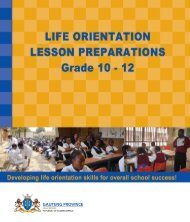Life Science Grade 11
Life Science Grade 11
Life Science Grade 11
You also want an ePaper? Increase the reach of your titles
YUMPU automatically turns print PDFs into web optimized ePapers that Google loves.
<strong>Grade</strong> <strong>11</strong> <strong>Life</strong> <strong>Science</strong>s Lesson Plans• Fungi may be classified into three groups: sporangium (produce spores in sporecases called sporangia), club (spores produced in club-shaped structures) andsac (spores produced in sac-like structures)• The structure of the bread mould Rhizopus will be examined• Bread mould grows best in warm, dark places• This bread mould is considered to be a thallus with no true roots, stems or leaves• It is made up of individual filaments called hyphae, that together from amycelium• The three types of hyphae are rhizoids, stolons and sporangiophores• Rhizoids penetrate the bread, stolons creep over the surface of the bread andsporangiophores are upright hyphae that have sporangia (produce spores)• Hyphae do not have chloroplasts• Little support is required since the mould is embedded in the bread so there is nostrengthening tissues• There is no transport required over large distances and the cells do not havecross walls so bread mould does not have conduction tissue• The cytoplasm of one cell is continuous with that of the next and this makes surethat food is transported easily to all parts of the fungus• Learners must draw a labelled diagram of the structure of Rhizopus in theirworkbookConclusion• Refer to chalkboard summary, transparency etc. and summarise the lesson. Itmay be necessary to restate the important concepts• Revise the terms thallus, hyphae, mycelium and rhizoids, stolons andsporangiophores with learners.• Remind learners to bring bread with mould growing on it for next lesson1. Learners must drawand label adiagram of breadmould (may becompleted ashomework)10 min10 min• Reference for diagrams: Solutions for all <strong>Life</strong><strong>Science</strong>s <strong>Grade</strong> <strong>11</strong> pp. 12; OxfordSuccessful <strong>Life</strong> <strong>Science</strong>s <strong>Grade</strong> <strong>11</strong> pp. 18Term 1 Page 12© Gauteng Department of Education (CAPS version)







